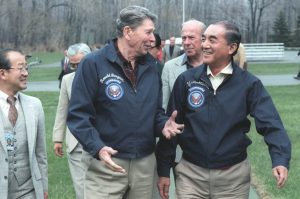When former Japanese Prime Minister Yasuhiro Nakasone passed away on November 29, the development understandably saw a raft of commentary noting his significance from a range of perspectives. One of the lenses through which his significance can be viewed is the state of U.S. Asia policy in the 1980s, which Nakasone found himself in the midst of as the leader of Japan at that time.
U.S. Asia policy in the 1980s evolved in a context where, despite the normalization of U.S. ties with China and détente with the Soviet Union in the 1970s, the Cold War was still playing out in Asia with the Soviet military buildup in the Pacific even as key Asian economies were achieving high levels of growth. During this period, the administration of President Ronald Reagan sought to roll back Soviet gains in the region; improve relations with major Asian powers such as Japan in a rising Asia after the focus on China that had been seen previously; thread the needle between ideals and interests amid democratic transitions in the Philippines and South Korea; and manage rising protectionist sentiment at home. While debates continue to persist about the extent to which Reagan had a grand strategy in foreign policy, the contours of his Asia policy nonetheless were quite clear after some initial disruption tied to Taiwan policy.
Nakasone was a central figure amid these developments. Even though Nakasone had initially pushed for a more autonomous vision of Japanese security as defense minister, he also oversaw a period as prime minister (1982-1987) when he and Reagan worked to manage the sense of drift and uncertainty in the alliance in what was termed as the “Ron-Yasu” relationship. Nakasone’s memorable description of Japan as a U.S. “unsinkable aircraft carrier” during his first visit to Washington in January 1983 is still quoted today. While that phrase may have overstated Japanese capabilities and understated the challenges the alliance faced in other realms – as evidenced by intense economic frictions that persisted due to protectionist sentiment in the United States – Nakasone’s leadership was nonetheless important in advancing U.S. efforts to blunt Soviet advances in the Pacific and proved a key moment in the broader evolution of the U.S.-Japan alliance.
Nakasone also presided over a period that saw a rising Asia seek a louder voice in how the region was being shaped, a messier, more multipolar Asia that Richard Nixon had written about in the pages of Foreign Affairs in 1967 but U.S. policymakers had to continue to gradually learn to adapt to including in the 1980s. A more active Japan was part of this reality, and the Nakasone government’s advancement of ideas for regionalism such as the-then Pacific Economic Cooperation Conference (PECC) and the management of ties with other Asian players, be it South Korea, China, or ASEAN, were one manifestation of this broader reality, which Washington would continue to contend with in the post-Cold War period as well.
The context of U.S. Asia policy in the 1980s is worth keeping in mind amid some of the trends and developments we are seeing today. Certain events in the 1980s also have lingering effects today, whether it be the negotiation of the Intermediate-Range Nuclear Forces (INF) Treaty, which Nakasone also played a role in and the United States has now exited, or Donald Trump’s own views on alliances and free trade, which, as they play out, to some extent reflect perceptions prevalent in the 1980s. And a few trends that occurred during the period, be it rising protectionism in the United States or evolving regionalism in Asia, can also be seen today and continue to pose challenges for policymakers.
To be sure, U.S. Asia policy is only one of the many lenses through which Nakasone’s legacy can analyzed and understood – with others including his relationship with other Asian states including China and South Korea as well as his domestic impact on Japan on issues such as defense spending and administrative reform. And he was also not without his limitations, some of which were seen during his tenure as prime minister and others which may become clearer as time progresses and more documentation from the period is declassified. Nonetheless, it is clear that Nakasone certainly left his mark on the evolution of Washington’s vision for the region in the 1980s and beyond.

































